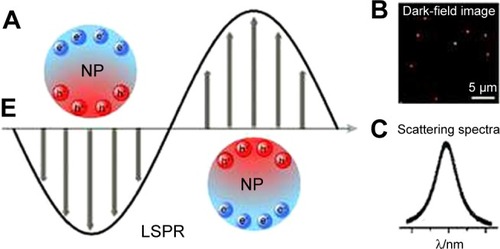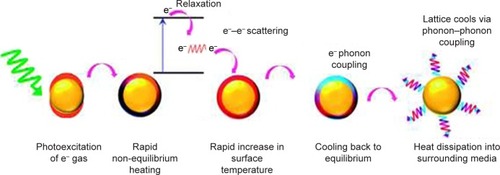Figures & data
Figure 1 (A) Schematic description of localized surface plasmon resonance in metal NPs. (B) Dark-field image of NPs. (C) Scattering spectrum of a single NP.
Notes: Reproduced from Xie T, Jing C, Long YT. Single plasmonic nanoparticles as ultrasensi tive sensors. Analyst. 2017;142(3):409–420,Citation25 http://pubs.rsc.org/en/Content/ArticleLanding/2017/AN/C6AN01852A#!divAbstract, with permission of The Royal Society of Chemistry.
Abbreviations: LSPR, localized surface plasmon resonance; NP, nanoparticle.

Figure 2 Schematic illustration of light to heat conversion by plasmonic nanostructures.
Notes: Step 1 is excitation of metal nanoparticles by the absorbed light photons, which results in particle oscillation and charge separation. Step 2 is conversion of the absorbed light to heat through electron–electron relaxation and electron–phonon relaxation processes, which result in the formation of hot metallic lattice. Step 3 is cooling off the metal structure through electron–phonon coupling and phonon–phonon relaxation, which cause heat dissipation. Reproduced from Webb JA, Bardhan R. Emerging advances in nanomedicine with engineered gold nanostructures. Nanoscale. 2014;6(5):2502,Citation27 http://pubs.rsc.org/en/content/articlelanding/2014/nr/c3nr05112a#!divAbstract, with permission of The Royal Society of Chemistry.

Table 1 Summary of different nanomaterials reported as PTT agents applied on various types of tumor cells
